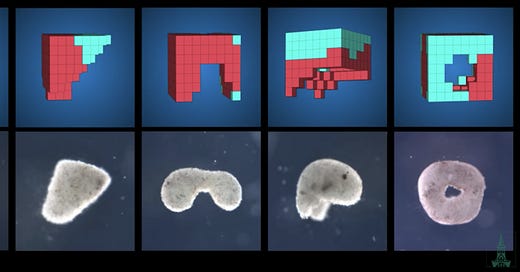The biopedal xenobot. The colors represent different cell types.
On Jan. 28, 2020 two scientists from the University of Vermont and Tufts University published together an article announcing the successful creation of a new life form, that functions like a robot. This lifeform is programmable to move and do tasks and it can also repair itself. It is the first robot that is not made of metal and plastic and so, has significant benefits over metal and plastic, as well as potential risks.
The “xenobot” takes the prefix “xeno-” meaning of a different origin, or foreign,1 and “bot” is simply short for robot (but has taken on a negative social meaning.)2
These xenobots are created by using two types of cells from a frog (Xenopus laevis) — cells that have structure and cells that have motion.
This frog, the African Claw Frog,3 has the ability to regenerate lost hindlimbs and tails at least while it is young. These cells are grown, disassembled and then reassembled, then sculpted into a programmable, self-repairing robot. These make the life form perform a function or task. These functions include movement in a certain direction, pushing matter and transporting matter. But perhaps most impressive is that they can be programmed to work together.
There is no genetic engineering in the design.
The movement is created by the choice of cells once the structure has been developed with structural cells. Researchers use cilia cells, which are hairlike structures that beat in a swimming motion and carry along single cell organisms in the natural world. To move in a rhythmic motion, researchers use cardiac cells from the frog:
“We use cardiac tissue because cardiac cells pulse at a regular rate, and that gives you sort of an inchworm type of movement if you build with it,” says Blackiston.4
Photo Credit: https://www.popsci.com/technology/xenobots/
They have even solved one of the lifecycle disposal problems of devices made of metal like robots, cellphones and windturbines. Environmentally they biodegrade, unlike disposal of plastics and metal for current robotic forms.
The risks
Like almost all technological research there is a potential application for military use.
The benefits and advantages of undetectable lifeforms with programmable tasks, coupled with “repairability” could pose new opportunities as well as new risks. This new life form could evade categorization in existing legal frameworks that might be needed to prohibit its use for war, for example.
The use of international law has historically been the collective, global conscience for the moral and ethical conduct of war, but the rapidly developing fields of biotechnology, robotics, nanotechnology, information and communication technologies and neurosciences (the five horsemen of technology) while combining and converging into new, exciting possibilities for improving human quality of life, they can pose significant risks to humanity, as well.
Does existing international law have a broad enough scope to include these xenobot lifeforms as prohibited weapons, or is more needed with interpretation of existing treaties?
We are witnessing almost the birth of a new discipline of synthetic organisms,” Columbia University roboticist Hod Lipson, who was not part of the research team, told the NYT. “I don’t know if that’s robotics, or zoology or something else.”
Xenobots are built at the nano-level using living cells (a cell is about 10,000 nanometers in size) but the built xenobot is large enough to see without magnification as you can see in the photo with the comparison to the dollar bill. They are built with artificial intelligence design in order to skip the 1,000s of “trial and error” experiments that would characterize the usual methods of development. The researchers start with a simple prompt like “use 5,000 cells and build me a xenobot that will walk in a straight line or pick something up”5 and hundreds of milliions of configurations will be generated. The process will also select the blueprints with the chance at being the most performative are selected the process.
Promising tasks for xenobots
In the cycle of the emergence of a new technology, I have identified one of the first stages as “parlor tricks”.6 At this stage, the new technology can do remarkable tasks but they may not be particularly useful and just be entertaining like a “parlor trick.” (In the field of nanotechnology, using atoms to spell the acronym “IBM” was the first task demonstrated with manipulating matter at the nanoscale — not particularly useful but entertaining.) Here, the researchers have photgraphed the xenobots pushing particulate matter around in a coordinated manner, you might say, a “parlor trick”.
After the parlor tricks stage, the next step is to apply the new technology to useful tasks. Teach the swarm, we will call it, to gather up cadmium particulate in water, and you have a life-saving, water purifying, game-changing technology.
Researchers have inserted photosensitive cells that can empower the xenobot to detect light. The xenobots can also “tell” the researchers where they have been by retaining some memory. The potential for this new technology is still folding. For example, the xenobots have been able to replicate and they were not programmed for that task.
History of the Nanoscale Movement and International Law
1974
The Biological Weapons Convention7 goes into effect. Definition of a biological weapons continues to be re-interpreted every five years. Xenobots do not fall within the current defintion interpretation.
1997
The Chemical Weapons Convention8 goes into effect. Xenobots could learn to transport chemical weapons and fall within the scope of the treaty.
2000
The first nano-tweezers. Tweezers open and close, but do not move.
New Scientist , (12 August 2000).
2008
Array of Nano tweezers made of liquid for manufacturing nanowires.)
2014
Nanotechnologies were considered at the Biological Weapons Convention 7th Rev. Conf. 2014 “other scientific advancements”
2020
Anew life form is invented.9 This graphic shows how the biped walks.
What should we do?
The xenobot arrived in 2020 during the pandemic. It is probably time to revisit this new technology and its potential with an open discussion about it.
In 2020, Germany volunteered to workshop ideas for conducting scientific reviews concerning new technologies. This process is still ongoing.10
My recommendation is that the Biological Weapons Convention Conference of Parties (2026) should specifically consider the xenobot in their proceedings to re-interpret Article I of the Biological Weapons Convention (which defines thescope of the treaty.) Then xenobots would be prohibited from use in war.
It is an exciting new technology that is currently advancing beyond the “parlor trick” stage, but in part because it evades our traditional legal categories for existing weapons treaties, it is one that warrants keeping a close eye.
Prof. Sutton is the author of Nanotechnology Law & Policy (2009), and teaches a course by the same title.
https://www.etymonline.com/word/xeno-
https://www.cyberdefinitions.com/definitions/BOT.html
https://www.nytimes.com/2022/01/26/science/frogs-grow-limbs-back.html
https://www.popsci.com/technology/xenobots/
https://www.popsci.com/technology/xenobots/
https://www.merriam-webster.com/dictionary/parlor%20trick
https://disarmament.unoda.org/biological-weapons
https://www.opcw.org/chemical-weapons-convention
S. Kriegman, et. al. “A scalable pipeline for designing reconfigurable organisms,” PNAS, Jan 2020 at https://www.pnas.org/content/117/4/1853
https://disarmament.unoda.org/biological-weapons/implementation-support-unit/relevant-activities-overseen-by-the-isu










